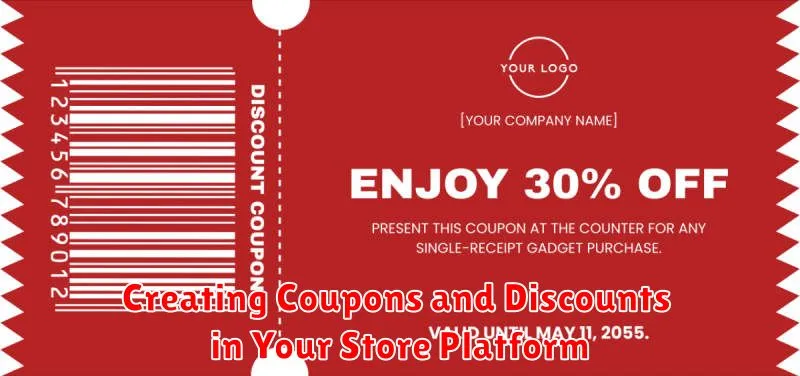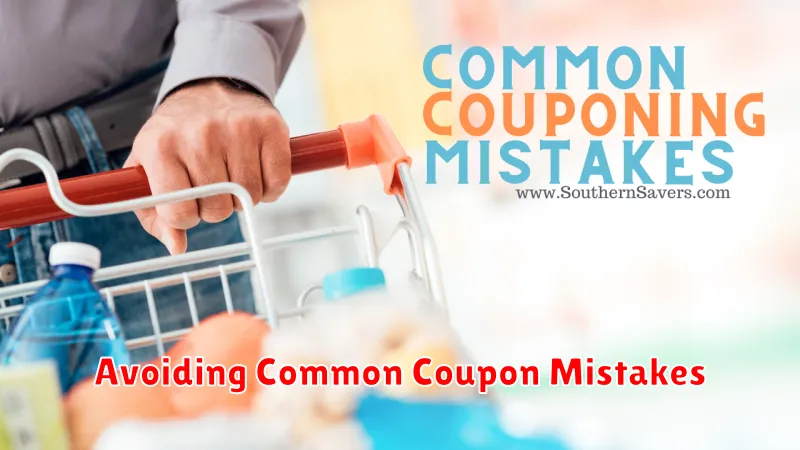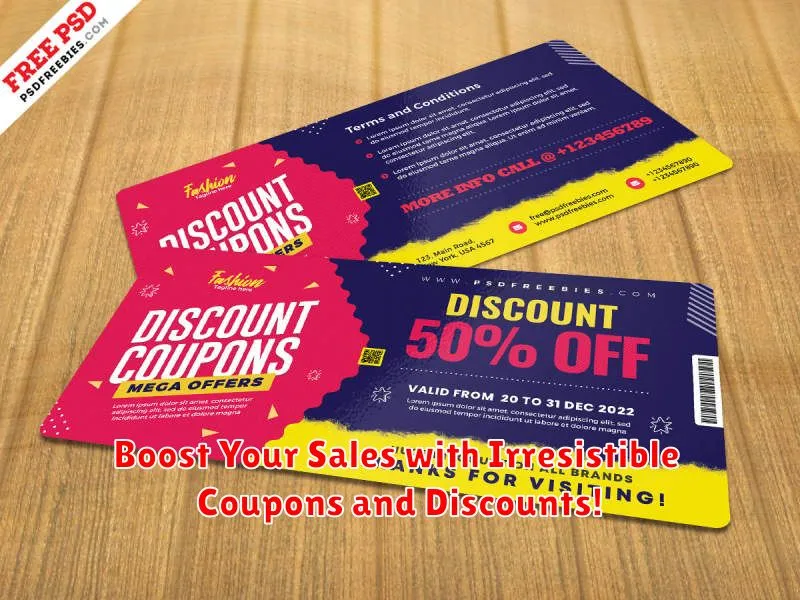In today’s competitive market, attracting customers and boosting sales requires strategic planning and enticing offers. One of the most effective methods for achieving significant sales growth is through the strategic implementation of coupons and discounts. These powerful tools can incentivize purchases, drive customer loyalty, and ultimately, boost your bottom line. This article will delve into the proven strategies for leveraging coupons and discounts to maximize their impact and propel your sales to new heights. Learn how to craft irresistible offers that capture attention, convert prospects into paying customers, and cultivate a loyal customer base.
Discover the secrets to creating a coupon and discount strategy that aligns with your business objectives and resonates with your target audience. From understanding the psychology behind consumer behavior to implementing various types of coupons and discounts, this guide provides valuable insights into optimizing your approach. Explore best practices for promoting your offers, measuring their effectiveness, and avoiding common pitfalls. Whether you are a seasoned business owner or just starting out, mastering the art of coupons and discounts is essential for achieving sustainable sales growth and staying ahead of the competition. Prepare to unlock the full potential of these powerful tools and transform your sales performance.
Understanding the Power of Coupons and Discounts
Coupons and discounts are powerful tools for driving sales and attracting new customers. They create a sense of urgency and encourage immediate purchases. Offering a discount can make a product or service more appealing to budget-conscious consumers.
Beyond immediate sales, coupons and discounts build brand loyalty. Customers appreciate feeling valued and rewarded, making them more likely to return for future purchases. They also contribute to a positive brand image, portraying your business as customer-centric.
Key Benefits of Coupons and Discounts:
- Increased Sales
- New Customer Acquisition
- Improved Brand Loyalty
- Enhanced Brand Image
- Inventory Clearance (for specific types of discounts)
Understanding the psychology behind why discounts work is crucial to utilizing them effectively. A perceived value increase motivates customers to take advantage of limited-time offers.
Types of Coupons and Discounts You Can Offer
Offering a variety of coupon and discount types can cater to different customer preferences and encourage various purchasing behaviors. Here are a few common and effective options:
Percentage Discounts
These are straightforward and popular, offering a percentage off the total purchase price. For example, a 10% discount or a 20% discount can entice customers to complete their purchase.
Fixed Amount Discounts
These offer a specific dollar amount off a purchase. This can be attractive for higher-priced items. Examples include a $5 discount or a $10 discount.
Free Shipping
Free shipping is a powerful incentive, especially for online shoppers. It removes a potential barrier to purchase and can significantly increase conversions.
Buy One, Get One (BOGO) Deals
BOGO deals are highly effective for increasing sales volume. They can be structured as “Buy One, Get One Free,” “Buy One, Get One Half Off,” or other variations.
Early Bird Discounts
Rewarding early adopters or customers who purchase within a specific timeframe can create urgency and boost initial sales. These are often used for new product launches.
Creating Coupons and Discounts in Your Store Platform

Most e-commerce platforms provide built-in tools for creating coupons and discounts. The process generally involves navigating to a specific section within your platform’s admin panel, often labeled “Promotions,” “Marketing,” or “Discounts.”
Within this section, you’ll typically find options to define the discount type (percentage or fixed amount), set the discount value, and create a unique coupon code if necessary. Some platforms also allow generating unique codes automatically.
You’ll also need to specify the duration of the promotion, including the start and end dates. Ensure the coupon code is easy to remember and relevant to the promotion if you are using one. For example, “SUMMER20” for a summer sale.
Setting Up Discount Rules and Restrictions
Effectively managing your discounts involves establishing clear rules and restrictions. This prevents misuse and ensures your promotions align with your business goals. Defining specific parameters helps control the impact of discounts on your profit margins.
Consider these common restriction options:
- Minimum purchase amount: Encourage larger orders by setting a minimum spending threshold.
- Product-specific discounts: Apply discounts only to certain items or categories to clear out inventory or promote new arrivals.
- Customer group restrictions: Offer exclusive discounts to specific customer segments like first-time buyers or loyal members.
- Date and time limitations: Create a sense of urgency with limited-time offers or schedule discounts for specific periods.
- Usage limits per customer: Prevent abuse by restricting how many times a single customer can use a coupon.
Your store platform likely provides settings to configure these restrictions. Carefully review these options and tailor them to your specific promotional strategy. Testing your discount rules before launching them is crucial to avoid unintended consequences.
Promoting Your Coupon and Discount Offers
Once you’ve created compelling coupons and discounts, strategic promotion is key to maximizing their impact. A multi-channel approach ensures broad reach and targets various customer segments.
Email Marketing
Email remains a highly effective method. Segment your list to target specific customer groups with tailored offers. Announce new discounts and remind customers about expiring coupons.
Social Media Engagement
Leverage the power of social media platforms. Run contests and giveaways, create engaging posts with visually appealing graphics, and use relevant hashtags to expand your reach. Consider using paid social media advertising to target specific demographics.
Website Banners and Pop-ups
Place prominent banners and pop-ups on your website to capture immediate attention. Highlight limited-time offers and exclusive deals to create a sense of urgency.
Partnerships and Influencers
Collaborate with complementary businesses or influencers to extend your reach to a wider audience. Offer exclusive discounts to their followers to incentivize purchases.
Tracking the Success of Your Coupon Campaigns
Monitoring your coupon campaign’s performance is crucial for maximizing your return on investment and refining your strategy. By tracking key metrics, you can identify what works, what doesn’t, and adapt your approach for better results.
Key Performance Indicators (KPIs) to consider include:
- Redemption Rate: This measures the percentage of distributed coupons that were actually used. A higher redemption rate indicates strong offer appeal and effective distribution.
- New Customer Acquisition: Track how many new customers are using your coupons. This metric helps assess the effectiveness of your campaigns in attracting new business.
- Sales Lift: Measure the increase in sales attributed to the coupon campaign. Compare sales during the campaign period to a previous period without coupons.
- Website Traffic: If using online coupons, monitor website traffic and conversions related to the campaign. This helps assess the effectiveness of your online promotion strategy.
- Return on Investment (ROI): Calculate the overall profitability of your campaign by comparing the total revenue generated against the cost of the coupon promotion.
By consistently tracking these KPIs, you can gain valuable insights into the effectiveness of your coupon campaigns and make data-driven decisions to optimize your future promotions.
Best Practices for Creating Effective Coupons
Creating effective coupons requires careful planning and execution. A well-structured coupon campaign can significantly impact your sales figures.
Clearly Define Your Objectives. Before launching any coupon campaign, establish what you aim to achieve. Are you targeting new customer acquisition, boosting sales of a specific product, or clearing out excess inventory? A clear objective guides your coupon design and distribution strategy.
Set a Realistic Budget and Expiration Date. Determine how much you’re willing to invest in your coupon campaign and set a clear expiration date to create a sense of urgency and encourage prompt redemption.
Target Your Audience. Tailor your coupon offers to specific customer segments. Consider demographics, purchase history, and browsing behavior to maximize the relevance and impact of your coupons.
Keep it Simple and Easy to Redeem. Complicated redemption processes can deter customers. Ensure the coupon terms are clear, concise, and easily understood. Simplify the redemption process, whether online or in-store, to minimize friction.
Avoiding Common Coupon Mistakes

While coupons can be a powerful tool for boosting sales, certain missteps can undermine their effectiveness. Avoid these common pitfalls to maximize your return on investment.
Unclear Terms and Conditions
Ambiguity in coupon terms can lead to customer frustration. Clearly state the expiration date, eligible products, and any usage restrictions. Transparency is key.
Difficult Redemption Process
A complicated redemption process can deter customers from using your coupons. Ensure the process is straightforward, whether online or in-store. Streamline the experience to encourage usage.
Overly Restrictive Limitations
Too many restrictions can make coupons less appealing. Strike a balance between preventing abuse and offering a valuable incentive. Consider the minimum purchase requirement and product exclusions carefully.
Insufficient Promotion
Don’t let your coupons go unnoticed. Promote them through various channels, such as email marketing, social media, and in-store displays, to ensure maximum visibility.

